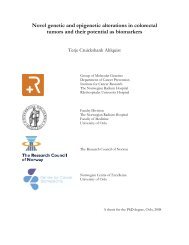Preface - Ous-research.no
Preface - Ous-research.no
Preface - Ous-research.no
You also want an ePaper? Increase the reach of your titles
YUMPU automatically turns print PDFs into web optimized ePapers that Google loves.
Focal hydrothermal ablation<br />
Principal investigator:<br />
Sumit Roy, Dept. of Radiology, Stavanger University Hospital<br />
Thermal destruction of tissue with the help of alternating electric current, radiofrequency ablation, has been steadily gaining acceptance<br />
as treatment for hepatic metastases that can<strong>no</strong>t be resected. The growth of the tumours can be halted, and an appreciable<br />
prolongation<br />
of survival can be achieved (that are <strong>no</strong>t amenable to surgery).<br />
However due to limitations imposed by the electrothermal processes underlying the procedure, the utility of radiofrequency ablation<br />
is largely restricted to relatively small tumours. The goal of the study is therefore to investigate whether interstitial instillation<br />
of steam in the target lesion, focal hydrothermal ablation, can be a more effective alternative. As the use of steam as energy vector<br />
avoids the intermediary step of converting electrical energy to thermal energy, more efficient transfer of energy to the lesion can<br />
be anticipated.<br />
The exclusion of dielectric heterogeneity as a confounding factor, could translate into more homoge<strong>no</strong>us and predictable heating<br />
of tumours being treated. Furthermore, steam’s high latent heat of condensation would permit very rapid deposition of large<br />
amounts of thermal energy at the target site, thereby considerably shortening the time required for treatment. Given that the<br />
thermal ablation with steam represents an entirely new concept, the study willaddress the fundamental questions of feasibility<br />
and efficacy, in an animal model.<br />
In-vivo evaluation of an implant for <strong>no</strong>n-sutured anastomosis<br />
Principal investigator<br />
Sumit Roy, Dept. of Radiology, Stavanger University Hospital<br />
A structurally sound, geometrically optimal anastomosis is the key to therapeutic success in peripheral vascular surgery. A simple<br />
technique for achieving this goal without suturing has for long been the focus of <strong>research</strong>. One product is currently commercially<br />
available for mechanically join peripheral blood vessels without sutures. However, it is unsuitable for use when the if the arterial<br />
wall is <strong>no</strong>t pliable, as is <strong>no</strong>t uncommon in elderly patients. Further, based on published literature, it is unlikely that the product can<br />
be incorporated into synthetic blood vessel substitutes commonly used in clinical practice.<br />
To satisfy the unmet need for a versatile method for anastomosing tubular organs without sutures, a simple, inexpensive implant<br />
has been developed. Based on the results of assessment of the first iterations of the implant in porcine coronary arteries, the<br />
design has been refined, and scaled up for use in larger arteries. The goal of the study is to determine whether the alterations in<br />
design serve their purpose.<br />
54
















